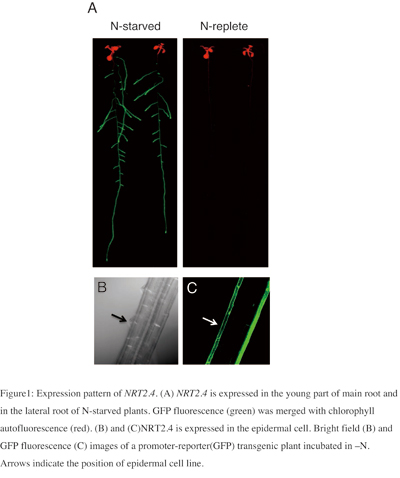
3. Discovery and utilization of genes relevant to beneficial plant traits
Plant productivity is determined by genetic factors and environmental parameters. We are studying not only the identification of gene functions regarding productivity, but also mechanisms that respond to environmental conditions.
To improve nitrogen use efficiency and nitrogen limitation tolerance in plants
Nitrogen (N) is one of the most important nutrients for plants; its availability often limits plant growth and productivity. In agricultural systems, the use of nitrogen fertilizers has increased crop yield over the past 50 years. However, excess nitrogen fertilizer use has created unintended human and environmental problems, including surface and groundwater pollution, biogenic greenhouse gas emissions, and an increase in production cost. To solve these problems, nitrogen fertilizer use must be curved. On the other hand, plants frequently face N-limited growth conditions in natural systems because excess N is easily leached by rainwater and/or consumed by microorganisms. Thus, plants have evolved elaborate responses including changes in morphology and metabolism, and an increase in nitrogen uptake to survive N-limiting conditions. A comprehensive understanding of the molecular network underlying these responses would lead to generating a crop with improved N use efficiency or N-limitation tolerance.

We have been focusing on the mechanism plants employ to absorb nitrogen nutrient (nitrate) efficiently in N-limited conditions. Nitrate uptake in N-limited conditions is carried out by a family of nitrate transporters NITRATE TRANPORTER 2 (NRT2). Among seven NRT2 family nitrate transporter genes in Arabidopsis, we have characterized two N-limitation inducible genes, NRT2.4 and NRT2.5 (Figure 1). We demonstrated that NRT2.4 is a high-affinity nitrate transporter involved both in root nitrate uptake at very low nitrate concentration and in delivering nitrate to the shoot phloem under nitrogen starvation (Kiba et al., 2012). We also revealed that NRT2.5 is a high-affinity nitrate transporter, playing an essential role in adult plants under N-limitation by ensuring the efficient uptake of NO3 and by taking a part in NO3 loading into the phloem during nitrate remobilisation (Lezhneva & Kiba et al., 2014). Furthermore, these studies suggested that multiple transporters (NRT2.1, NRT2.2, NRT2.4, and NRT2.5) spatially and temporally cooperate with each other to optimize adaptation of plants to N limitation (Kiba et al., 2012; Lezhneva & Kiba et al., 2014). Now we are studying the transcriptional regulatory mechanism underlying the efficient uptake of nitrate.
Kiba et al (2012) Plant Cell 24, pp245-258.
Lezhneva & Kiba et al (2014) Plant J 80, pp230-241
Riken Research: http://www.riken.jp/en/research/rikenresearch/highlights/6947/

